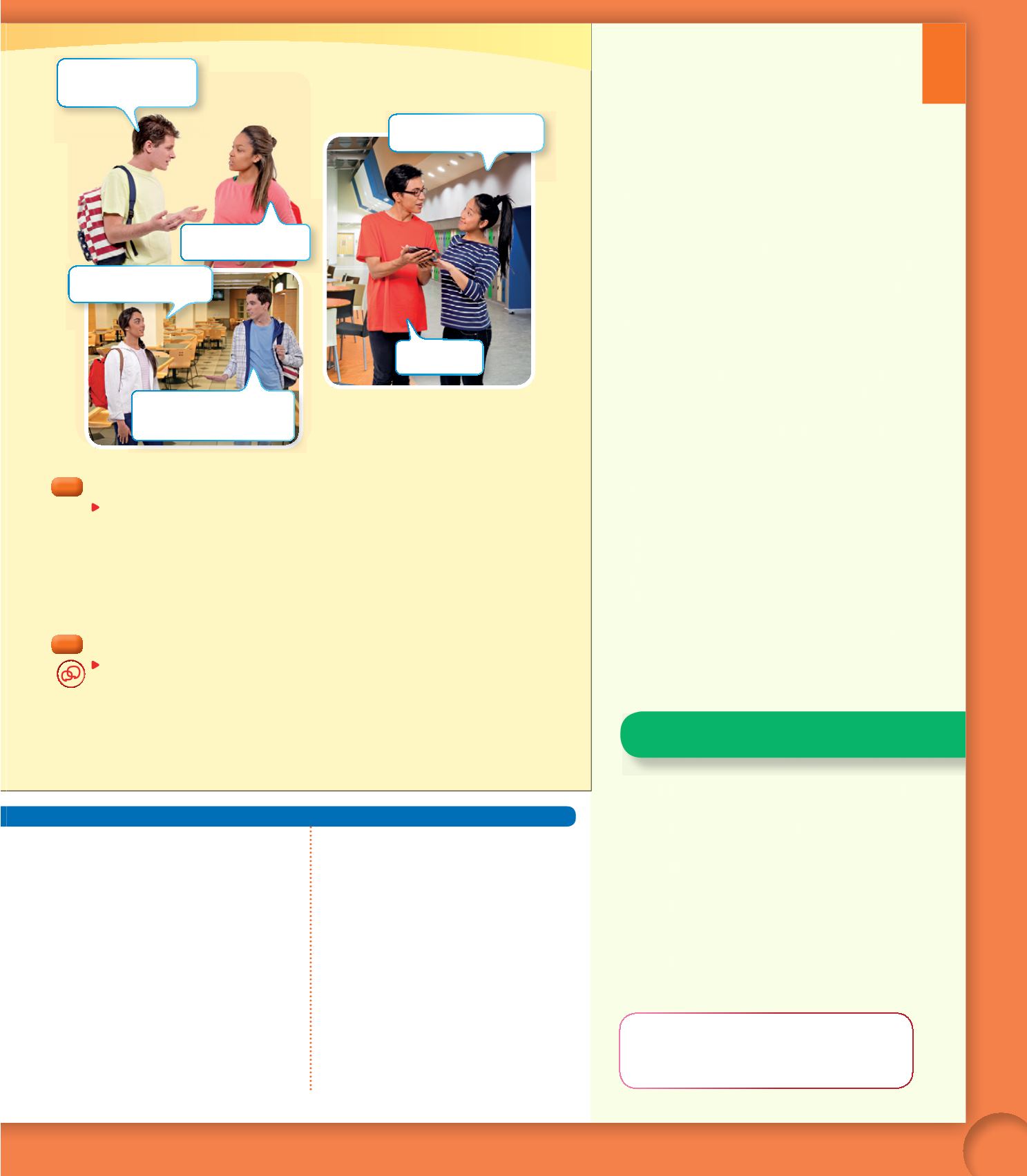

69
Las tareas
Unit
6
HERITAGE LANGUAGE LEARNERS
r
Ask students to share with the class any
information they may have (or can research)
on leading muralists or other artists from
their family’s country of origin, as well as
well-known architects or writers. Students
may prepare a brief biography on one or two
of these artists, and bring in images of their
major works or read excerpts from some of
their selected literary pieces. Encourage the
rest of the class to ask questions about the
lives and artistic contributions these
individuals have made or continue to make.
MULTIPLE INTELLIGENCES:
Visual-Spatial Intelligence
r
Ask students to imagine that they have been
living abroad for several months and want to
share their new surroundings with friends
back home. First, they have to decide in
which Spanish-speaking country they have
been living. Then, they need to focus on a
city and its landmarks. Next, they will
prepare a “digital tour” of some key sites
of their city with images taken from the web
or from printed media. Students should be
prepared to give background information on
the selected images.
Texto: Patrimonio cultural
.
Read the title aloud and ask students to explain
the term
patrimonio cultural
. If students are
having some difficulties with the word
patrimonio
,
give them this synonym:
herencia
. Then invite
students to provide examples of cultural heritage.
Is there a consensus on the type of things that
make up a cultural heritage?
.
Read the introduction to the text aloud, and then
ask for three volunteers to read the
desafíos
aloud. Write down two word categories on the
board (
arte
and
literatura
), and ask students
to associate words from the text with the
corresponding category. For example:
arte
→
pinceles, paletas
;
literatura
→
relato, escritor
.
Activities
1.
To expand this activity, ask students to describe
the three challenges in detail. Brainstorm
with them vocabulary used to talk about art,
architecture, and literature, such as
pintura,
escultura, diseño, edificio, poesía, novela,
etc.
2.
Ask students to express themselves about
artists that they admire, whether they are from
the Spanish-speaking world or not. You may get
them started with these or similar questions:
¿Por qué te gusta X? ¿En qué es diferente de Y?
¿En qué se parece?
Answer Key
1.
1. Van a ayudar a un grupo de universitarios
a pintar un mural.
2. Van a preparar un
tour
digital de la
catedral de Los Ángeles.
3. Porque tienen que mezclar la literatura
con el arte visual.
4. Ethan y Eva: pintura; Michelle y Daniel:
arquitectura; Asha y Lucas: literatura
y artes visuales.
5. Answers will vary.
2.
Answers will vary.
1
¿Comprendes?
Responde
a estas preguntas.
1.
¿En qué consiste el desafío de Ethan y Eva?
2.
¿Qué van a hacer Michelle y Daniel en Los Ángeles?
3.
¿Por qué el desafío de Lucas y Asha es doblemente artístico?
4.
¿Con qué categoría de arte se relaciona el desafío de cada pareja?
5.
En tu opinión, ¿por qué dice Picasso que «el arte es una mentira que nos acerca
a la verdad»? ¿Qué significan sus palabras?
2
Piensa
Habla
con tu compañero(a). Hagan una lista de artistas y escritores(as) que conozcan.
¿Cuántos son de origen hispano? Comenten lo que saben sobre cada uno(a).
Modelo
A.
Yo conozco a un arquitecto español muy famoso que se llama Gaudí. Sus obras más conocidas
están en Barcelona y creo que son de finales del siglo
XIX
, pero no estoy muy segura.
B.
Ah, sí, es el autor del templo de la Sagrada Familia.
& ( " &' ' % & (!
" % &'%
%$( ' '(%
0 (% &' & * !"& "
!" "!", " ! ! (!" 0
) "& " % %
& 3"
3 ' ! " ( &
! & ) & ' %
5 "
!) &' % "& "! "
&" % & &' " %'3&' "
(#"! " $( "& 3 " "
"% & ! & ( 0!"
" " &2 "+
% (! ) &' ,"
3!
!( &'%" %" ' *'"
% $(3 )( )" ! (! # &
Additional Resources
Fans Online activities
Practice Workbook
301
Book 4 Unit 6


















